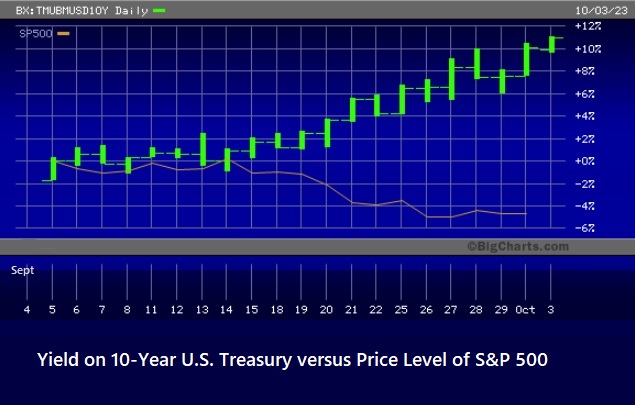By Pam Martens and Russ Martens: October 3, 2023 ~
The Fed’s problem and the U.S. Treasury’s problem just became the problem of every American who has their retirement savings stuffed in the stock market via 401(k) plans or direct holdings.
As the chart above shows in crisp terms, stocks do not like yields on the 10-year U.S. Treasury note rising to a level that is competitive with the return on stocks – especially since the principal on the Treasury note is guaranteed at maturity while the principal in the stock market is guaranteed to take one’s stomach on a roller coaster ride.
Last evening, the 10-year U.S. Treasury note had spiked to a yield of 4.682 percent, its highest yield since 2007. As of early this morning, its yield had spiked even higher, to 4.738 percent, making a 5 percent handle increasingly possible.
In response to the competition from Treasury securities and chaos in running the U.S. government, stocks have sold off in 8 of the last 10 trading sessions through Monday.
The Dow Jones Industrial Average, which closed last year at a level of 33,147.25, closed yesterday at 33,433.35, a negligible gain of less than 1 percent. The Russell 2000 index of small caps went negative yesterday on a year-to-date basis. Only the two indices with heavy weightings from the Big Tech bubble are showing solid gains year-to-date: the S&P 500 is up 11 percent while the Nasdaq Composite has soared by 26 percent.
Part of the ongoing problem for the stock market – regardless of what the Fed does with further interest rate hikes – is that Treasury supply is growing and requiring higher yields to attract demand.
In its quarterly refunding statement for the third quarter, the Treasury said it planned to issue $671 billion of debt, which was $178 billion more than the amount of Treasury securities that were maturing.
The projection for the fourth quarter of this year is even more sobering. The Treasury shows it has $582.45 billion of Treasury debt maturing, but plans to issue $921 billion – or $338.55 billion of new debt.
On September 21, the U.S. Treasury’s Assistant Secretary for Financial Markets, Josh Frost, delivered a speech in which he indicated that “we expect that further gradual increases in coupon auctions sizes will likely be necessary in future quarters.”
Frost also indicated that the Treasury is, apparently, going to join the thinking of the wizards at the Wall Street mega banks who prop up their banks’ share prices by spending tens of billions of dollars a year buying back their own stock. Frost shared the following with his audience:
“After careful consideration, we decided it was prudent to move forward and announced our intentions at the May refunding to implement a regular buyback program next year. We believe buybacks can play an important role in helping to make the Treasury market more liquid and resilient by providing liquidity support. The buyback program will also help Treasury to better achieve our debt management objectives….”
The Fed, as you might recall, called its Treasury buyback program Quantitative Easing or QE for short. The Fed is now attempting to whittle itself out of the $9 trillion mess to its balance sheet that resulted from that radical experiment by shrinking its balance sheet. So far, it’s whittled away about $1 trillion.
Which means that a new buyer of last resort for Treasury securities is needed. But should that really be the same entity that is issuing the debt in the first place? If the Treasury has the money to buy back its debt, why is it issuing the debt? Adding to the double speak, Frost said this during his speech on September 21:
“While we believe it is important that we retain some flexibility in providing incremental liquidity support to certain sectors of the Treasury market, it is important we make it clear at the outset that these buybacks are not intended to ameliorate periods of acute market stress. Unlike the Federal Reserve System, which can finance purchases of securities by creating reserves, each dollar of buybacks needs to be financed with a dollar of Treasury issuance, all else equal. This limits our ability to rapidly increase the size of buybacks to a level potentially necessary to alleviate market stress without resulting in significant costs for the taxpayer, as a corresponding rapid rise in Treasury issuance could materially increase our financing costs during these periods.”
To put this more bluntly, don’t expect the Treasury to perform the same magic alchemy in the markets as the Fed, which can create trillions of dollars in buying support at the push of an electronic button. (See Federal Reserve Spokesman Explains How It Creates Money Out of Thin Air to Pump Out to Wall Street.)


